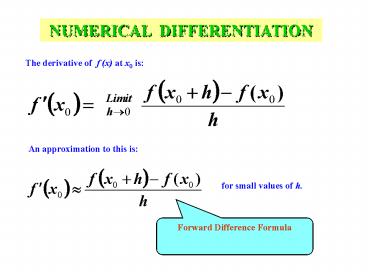NUMERICAL DIFFERENTIATION - PowerPoint PPT Presentation
1 / 48
Title:
NUMERICAL DIFFERENTIATION
Description:
If the points are equally spaced with x0 in the middle: ... Area of the trapezoid. The length of the two parallel sides of the trapezoid are: f(a) and f(b) ... – PowerPoint PPT presentation
Number of Views:871
Avg rating:3.0/5.0
Title: NUMERICAL DIFFERENTIATION
1
NUMERICAL DIFFERENTIATION
The derivative of f (x) at x0 is
An approximation to this is
for small values of h.
Forward Difference Formula
2
Find an approximate value for
The exact value of
3
Assume that a function goes through three points
Lagrange Interpolating Polynomial
4
(No Transcript)
5
(No Transcript)
6
If the points are equally spaced, i.e.,
7
Three-point formula
8
If the points are equally spaced with x0 in the
middle
9
Another Three-point formula
10
Alternate approach (Error estimate)
Take Taylor series expansion of f(xh) about x
11
(No Transcript)
12
(No Transcript)
13
2 X Eqn. (1) Eqn. (2)
14
(No Transcript)
15
(No Transcript)
16
The Second Three-point Formula
Take Taylor series expansion of f(xh) about x
Take Taylor series expansion of f(x-h) about x
Subtract one expression from another
17
(No Transcript)
18
Summary of Errors
19
Summary of Errors continued
20
Example
Find the approximate value of
with
21
Using the Forward Difference formula
22
Using the 1st Three-point formula
23
Using the 2nd Three-point formula
The exact value of
24
Comparison of the results with h 0.1
25
Second-order Derivative
Add these two equations.
26
(No Transcript)
27
NUMERICAL INTEGRATION
area under the curve f(x) between
In many cases a mathematical expression for f(x)
is unknown and in some cases even if f(x) is
known its complex form makes it difficult to
perform the integration.
28
(No Transcript)
29
(No Transcript)
30
Area of the trapezoid
The length of the two parallel sides of the
trapezoid are f(a) and f(b) The height is b-a
31
Simpsons Rule
32
(No Transcript)
33
(No Transcript)
34
(No Transcript)
35
(No Transcript)
36
(No Transcript)
37
(No Transcript)
38
Composite Numerical Integration
39
Riemann Sum
The area under the curve is subdivided into n
subintervals. Each subinterval is treated as a
rectangle. The area of all subintervals are
added to determine the area under the curve.
There are several variations of Riemann sum as
applied to composite integration.
40
In Left Riemann sum, the left-side sample of the
function is used as the height of the individual
rectangle.
41
In Right Riemann sum, the right-side sample of
the function is used as the height of the
individual rectangle.
42
In the Midpoint Rule, the sample at the middle of
the subinterval is used as the height of the
individual rectangle.
43
Composite Trapezoidal Rule Divide the interval
into n subintervals and apply Trapezoidal Rule in
each subinterval.
where
44
Find
by dividing the interval into 20 subintervals.
45
(No Transcript)
46
Composite Simpsons Rule Divide the interval
into n subintervals and apply Simpsons Rule on
each consecutive pair of subinterval. Note that
n must be even.
47
where
Find
by dividing the interval into 20 subintervals.
48
(No Transcript)































